Tsushima's best shell
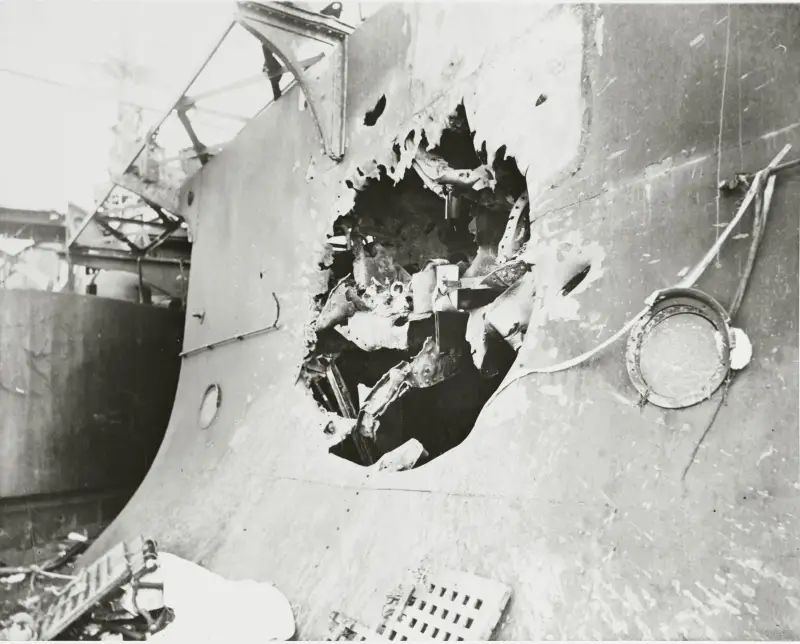
Design of a 12-dm high-explosive projectile
In 1892, the Naval Technical Committee for Artillery began designing new shells. The high-explosive shell was intended to destroy earthen coastal fortifications and unarmored parts of the ship. The demands placed on him turned out to be very contradictory.
On the one hand, it was necessary to reduce the thickness of the projectile walls as much as possible in order to accommodate the largest possible explosive charge.
On the other hand, thickening of the walls was allowed in order to reduce the cost of the projectile.
On the third hand, the strength of the head of the projectile had to ensure penetration of thin armor or other barriers, and therefore the hole for the fuse had to be placed in the bottom part.
Perm factories reported their readiness to start producing 12-inch forged steel projectiles with a bursting charge of 7,75% of the total weight (25,7 kg) from high-quality steel with an elastic limit of 3 atmospheres. However, the price of such a projectile, 800 rubles, turned out to be too high. A less technologically advanced cast thick-walled 265-inch projectile made of open-hearth steel with an elastic limit of 12 atmospheres, containing an explosive charge of no more than 2% of the total weight (700 kg), was valued by the same Perm factories at 3,8 rubles. It was put into service in 12,5.
The choice was not dictated only by concern for saving government funds. Objectively appetites fleet were limited by the capabilities of domestic metallurgy. In the 90s of the XNUMXth century, only the Putilov plant was able to master the production of large-caliber armor-piercing shells. The production of thin-walled large-caliber high-explosive shells was no less difficult.
The capacity for smelting crucible steel, from which armor-piercing projectiles and high-quality tools were made at that time, was severely limited. Thus, in 1894–1895, the Putilov plant smelted 24,1 thousand tons of steel in the main open-hearth furnace, 21,8 thousand tons in the acidic open-hearth furnace, 42,3 thousand tons in the Bessemer furnace, and only 519 tons in the crucible.
Thus, there was no other real alternative to the high-explosive shells of 1894.
The design of a 12-dm high-explosive projectile of the 1894 model
The high-explosive shells adopted for service contained little explosive, so they could not be counted on to tear large holes in the outer side. But they received another bonus - the ability to penetrate thin armor and even concrete. Therefore, it was decided to equip them with a delayed Brink fuse, with the expectation of damaging the interior of the ship or ground fortifications.
It was planned to use wet pyroxylin as an explosive for all high-explosive shells with a caliber of 6 dm and more. But the production of large blocks of patterned pyroxylin turned out to be difficult, so 12-dm shells had to be equipped with fine-grained smokeless gunpowder and a fuse of the 1894 model until the end of the Russo-Japanese War.
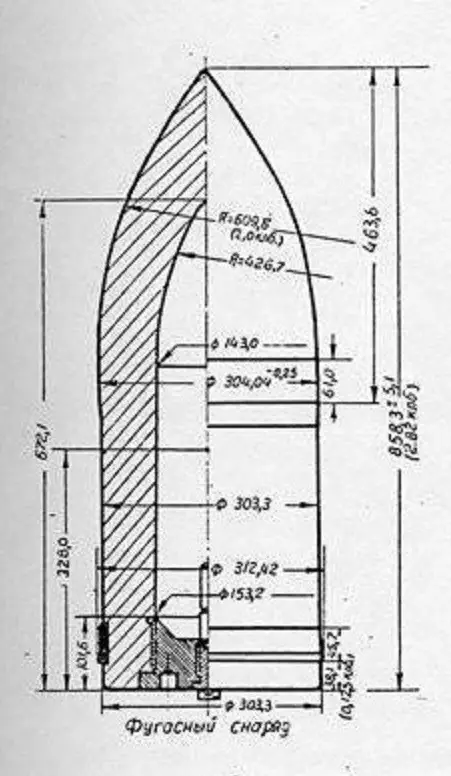
Russian 12-dm high-explosive projectile, model 1894
The weight of the loaded 12-dm high explosive was 331,7 kg, of which the unloaded projectile was 319,2 kg, smokeless powder was about 6 kg (maximum up to 7 kg), the fuse was almost 0,3 kg and another about 6,2 kg. lead weights, which were placed in order to bring the weight of the projectile to the standard weight.
Combat use in the Battle of Tsushima
In the cellars of the battleships of the 2nd Pacific Squadron there were three types of combat 12-dm shells: armor-piercing, high-explosive and segmented, as well as training cast-iron ones. Combat manuals prescribed the use of armor-piercing shells against armored ships from a distance of less than 20 cables, high-explosive shells against armored ships from a distance of more than 20 cables and cruisers, and segmental shells against destroyers.
Based on the results of the battles of the 1st Pacific Squadron, the opinion was formed that our shells were better than Japanese ones.
- this is how Lieutenant A. A. Redkin, in a letter to his father, recounted the combat experience of captain 2nd rank V. I. Semenov.
After the defeat in the Battle of Tsushima, public opinion changed dramatically. The 2nd Pacific Squadron had a great advantage over the enemy in the largest 12-dm guns: 26 barrels versus 16, but this did not prevent defeat. After the battle, Russian officers discussed the reasons for the defeat, and domestic high-explosive shells were named as one of them (due to the long distance, armor-piercing shells were almost never used).
The complaints boiled down to three points:
1. Insufficient sensitivity of the fuse, which is why it did not work when hitting water and thin obstacles. Many shells did not explode, which made zeroing very difficult.
2. A large fuse delay, due to which the shell exploded inside the ship or even on takeoff and was poorly visible. The holes in the outer side were only slightly larger than the caliber of the projectile, and the explosion behind the ship caused no damage at all.
3. Insufficient explosives, resulting in little damage to enemy ships.
To what extent did these claims apply to 12-inch shells?
The answer can only be combat experience!
Fuse sensitivity
The fuse for the 12-inch high-explosive projectile was a tube of the 1894 model, which, unlike the Brink fuse, had high sensitivity and low delay. The shells usually exploded upon impact with the water and gave a clearly visible splash, which made shooting easier.
A Japanese photograph shows the fall of the first Russian shell in the battle on July 28, 1904 in the Yellow Sea. This shot was fired by the battleship Tsesarevich.
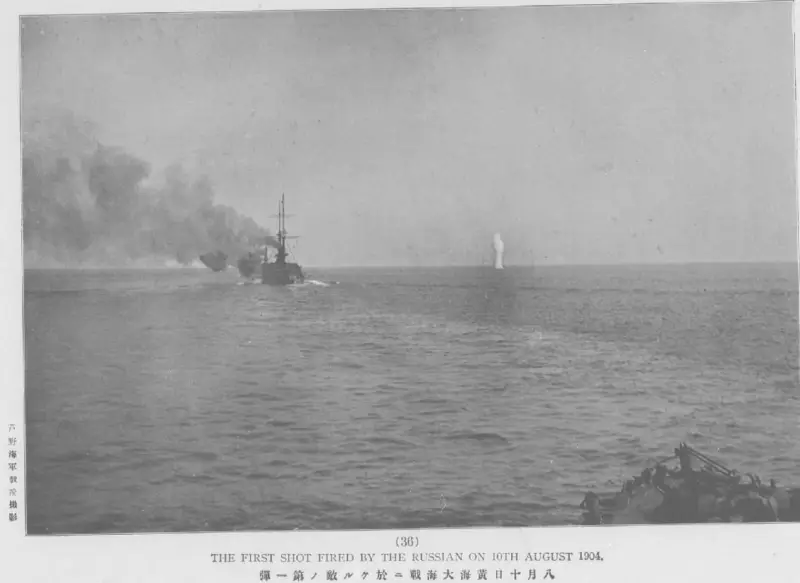
The first shot of the Russian fleet in the battle on July 28, 1904
Combat reports from participants in the Battle of Tsushima record numerous cases of large Russian shells exploding upon impact with water, for example:
There have been cases of Russian 12-inch shells bursting when hitting light structures: pipes, superstructures. But the most striking evidence of the high sensitivity of the fuse was when it hit the cruiser Kasuga at 14:15 (14:33 Japanese time).
Shrapnel in many places pierced the upper deck, mast, boats and many other nearby objects.
Shrapnel action
A clear illustration of the fragmentation effect is when a 12-inch shell hit the battleship Shikishima at 15:00 (15:18 Japanese time). The shell hit the lower part of the 152-mm Harvey slab of casemate No. 6 from the left side, chipped its edge in an area approximately 70 cm wide and 30 cm high, made a hole in the upper deck, ricocheted down and exploded on the middle deck in the officer's hospital. There was a fire. A hole of about 1x1 meter formed in the outer side, into which water poured in.
The victims of the shell were 11 people killed and 14 wounded. On the upper deck, shrapnel killed five lower ranks and wounded two officers in casemate No. 6, and also wounded two sailors serving 12-pound shells. On the middle deck, 6 sailors were killed and 4 were injured. The fragments penetrated through the elevator pipe to the lower deck, where they wounded 3 lower ranks. Two more sailors were wounded in the corridor of the shell magazine, and one officer was wounded in front of the officer’s restroom on the starboard side.
As a result of the explosion, the following were damaged: the officer's infirmary, the wardroom, the buffet, the officer's galley, the bathroom, the officer's latrine, the officers' cabins, the drying room, the bulkheads on the middle deck, the chimney casing, the flooring of the upper and middle decks, the shell feed elevator, the coal loading, fire fighting system pipe, drainage system pipe, speaking pipes, telephone set.
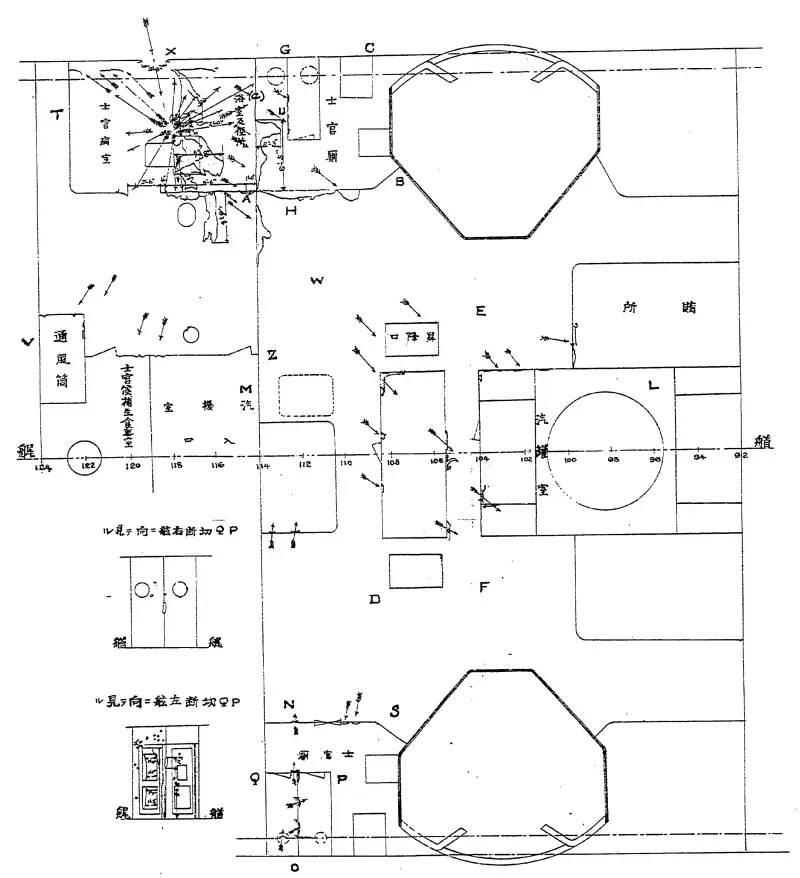
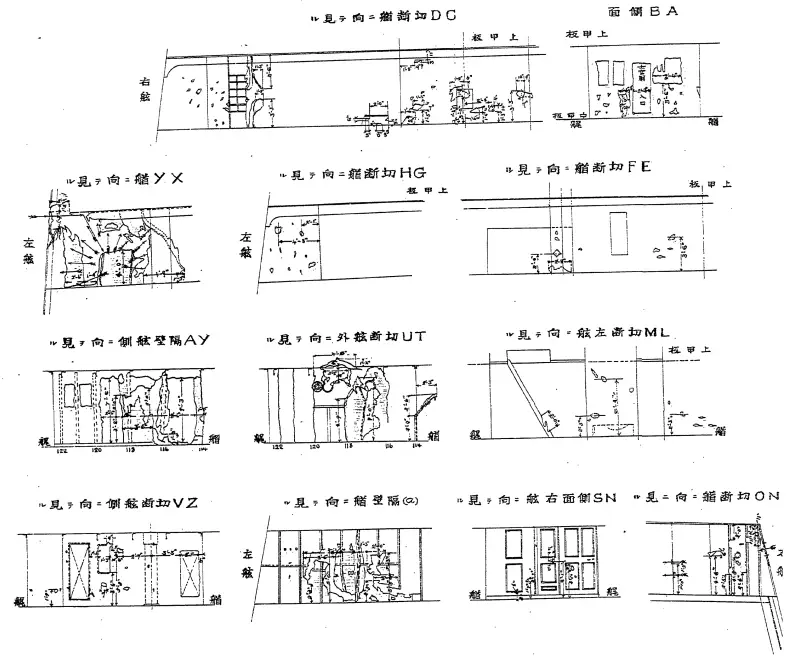
Diagram of damage to the battleship "Shikishima" from a 12-dm shell
Thus, the 12-inch Russian shell demonstrated a magnificent fragmentation effect, hitting a huge area on three decks right up to the opposite side.
High explosive action
A striking example of a high-explosive effect is when a 12-inch shell hit the battleship Mikasa at 15:57 (16:15 Japanese time). The shell hit at a significant angle from the normal, but successfully pierced the 148-mm Krupp plate of the upper belt and exploded in the 21st coal pit, filled to the top, just below casemate No. 7. A hole about 1 meter wide and 30,5 high was formed in the outer side cm. The force of the explosion turned out to be so powerful that it bulged upward the 25-mm middle deck and tore a hole in it measuring 2x1,7 meters, pierced the bulkheads separating the 21st coal pit from the neighboring 19th coal pit and the lower deck. About 5 tons of coal were thrown into casemate No. 7 and onto the lower deck.
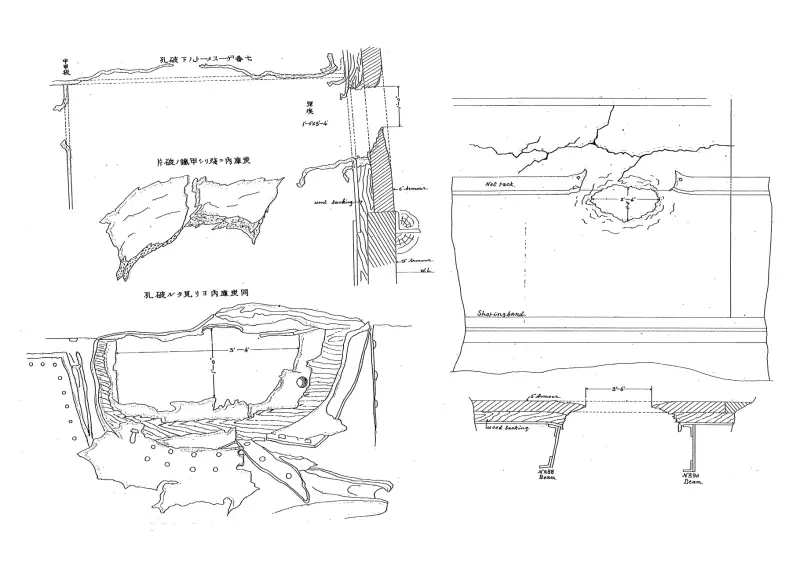
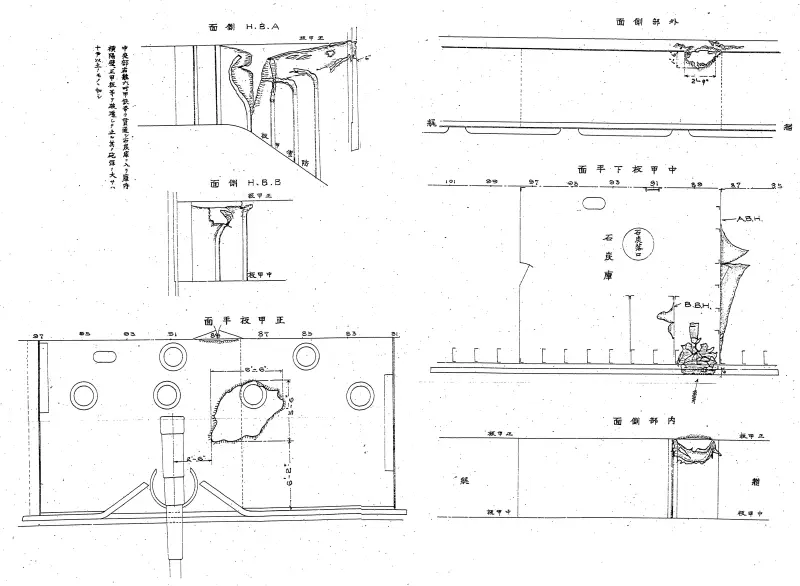
Diagram of damage to the battleship "Mikasa" from a 12-dm shell
One person was killed, six were wounded, one of whom died soon after.
The examples described above demonstrate the high effectiveness of a 12-inch high-explosive projectile when hitting the internal compartments of a ship, even those protected by armor. However, if the projectile hit light structures: superstructures, pipes, watercraft, etc., then its effect predictably turned out to be much more modest. The small explosive charge had an effect.
Armor penetration
In the battle of July 28, 1904, two cases of penetration of the 148...173 mm Krupp armor of the Mikasa were recorded. In the Battle of Tsushima, surface-hardened armor with a thickness of 148...152 mm was pierced 6 times. Based on these statistics, we can conclude that the 173-mm Krupp armor and the 178-mm Harvey armor, which was considered weaker, at actual combat distances did not guarantee protection against Russian shells of the largest caliber.
For example, on the battleship Asahi, only the conning tower, barbette, main caliber turret on the front and rear sides, and the side in the central part along the waterline were reliably protected from Russian 12-inch shells. For clarity, these zones are outlined in red in the diagram:

Reservation scheme for the battleship "Asahi"
On the Asama, only the conning tower remained impenetrable from Russian 12-inch shells:

Reservation scheme for the armored cruiser "Asama"
The facts clearly indicate that theoretically Russian 12-inch shells could decide the outcome of the Battle of Tsushima in their favor, but for them to prove themselves, they had to... hit.
According to the author's calculations, in all twelve Japanese armored ships of the 1st and 2nd detachments hit about twenty five 12 inch shells.
Много это или мало?
According to the experience of the Battle of Jutland, approximately the same number of large shells were required each to the German battle cruiser to inflict critical damage!
In addition, the severity of the damage depends greatly on the location of the projectile impact. But only four out of ten 12-inch hits on the Mikasa fell below the upper deck. The effect of other projectiles on superstructures, pipes and masts was not always effective.
12-dm high-explosive shells of foreign navies
The Russian 12-inch high-explosive projectile should definitely be compared with similar projectiles that were in service with other naval powers during the Russo-Japanese War: England, France, the USA and Japan. The German fleet at this time was equipping new battleships with 280 mm guns, so German high-explosive shells were not included in the review.
In the English fleet, the analogue of the domestic high-explosive projectile was a general purpose projectile (common), which was cast from steel, had a weight of 385,6 kg and a charge of 37,8 kg of black powder. Unfortunately, instead of an image of a 12-inch projectile, its smaller counterpart is shown below.
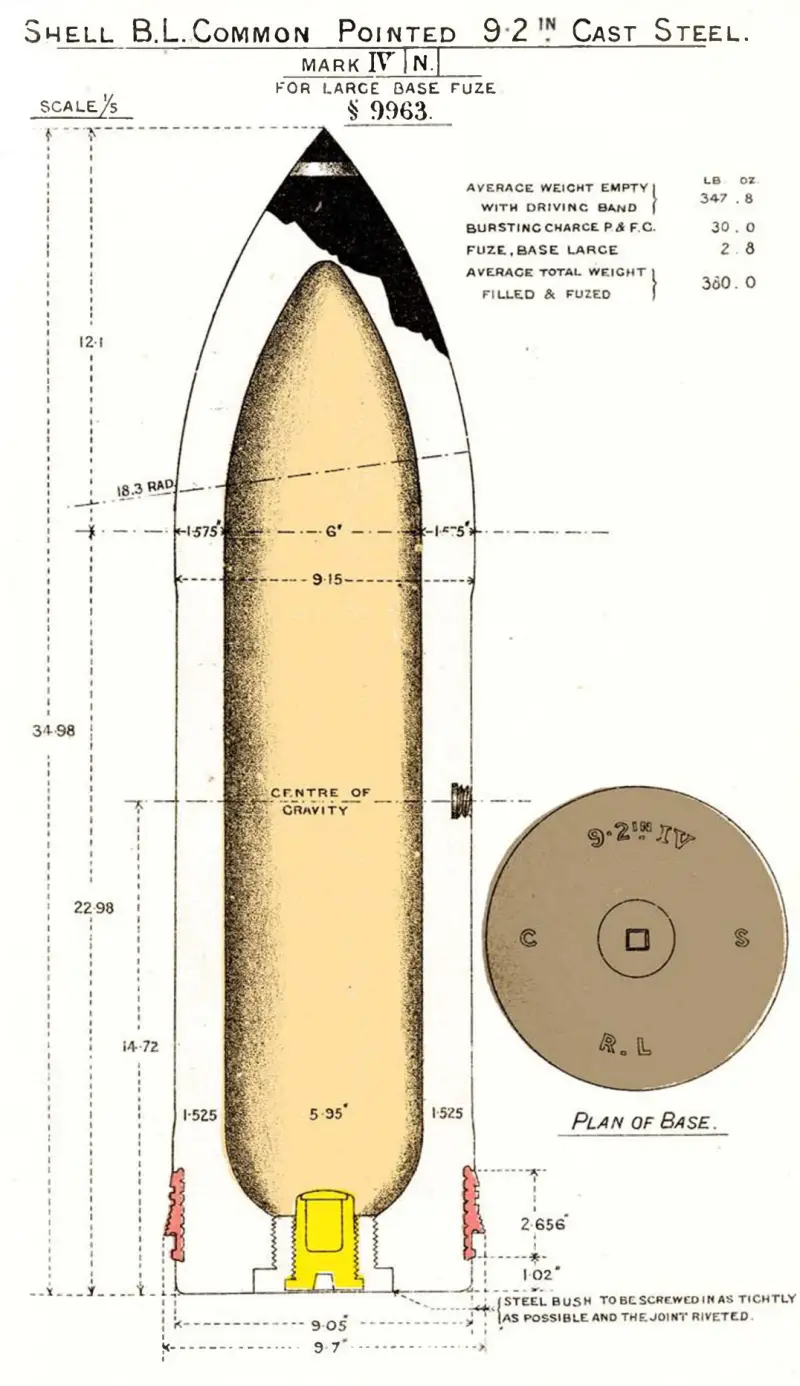
English 9,2-dm general purpose projectile
In the US Navy, the general purpose projectile (common) was forged from steel, weighed 394,6 kg and was loaded with 16,33 kg of black powder.
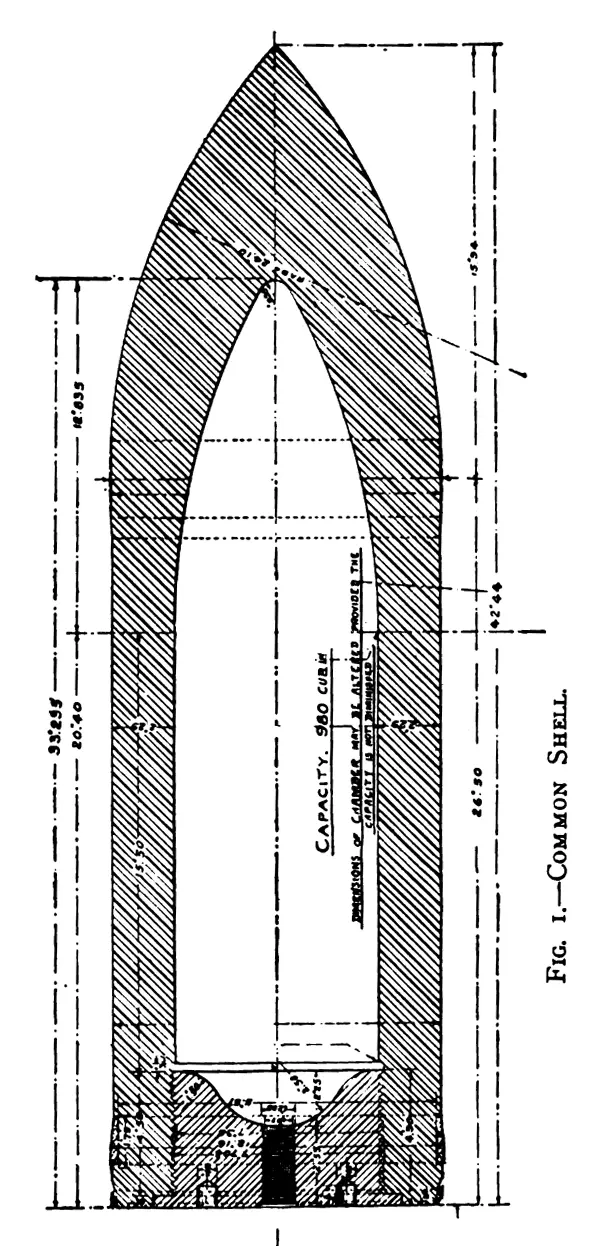
American 12-dm general purpose projectile
The French navy used a cast iron shell (obus en fonte) with a head fuse, which weighed 292 kg and had a charge of 20,2 kg of black powder.
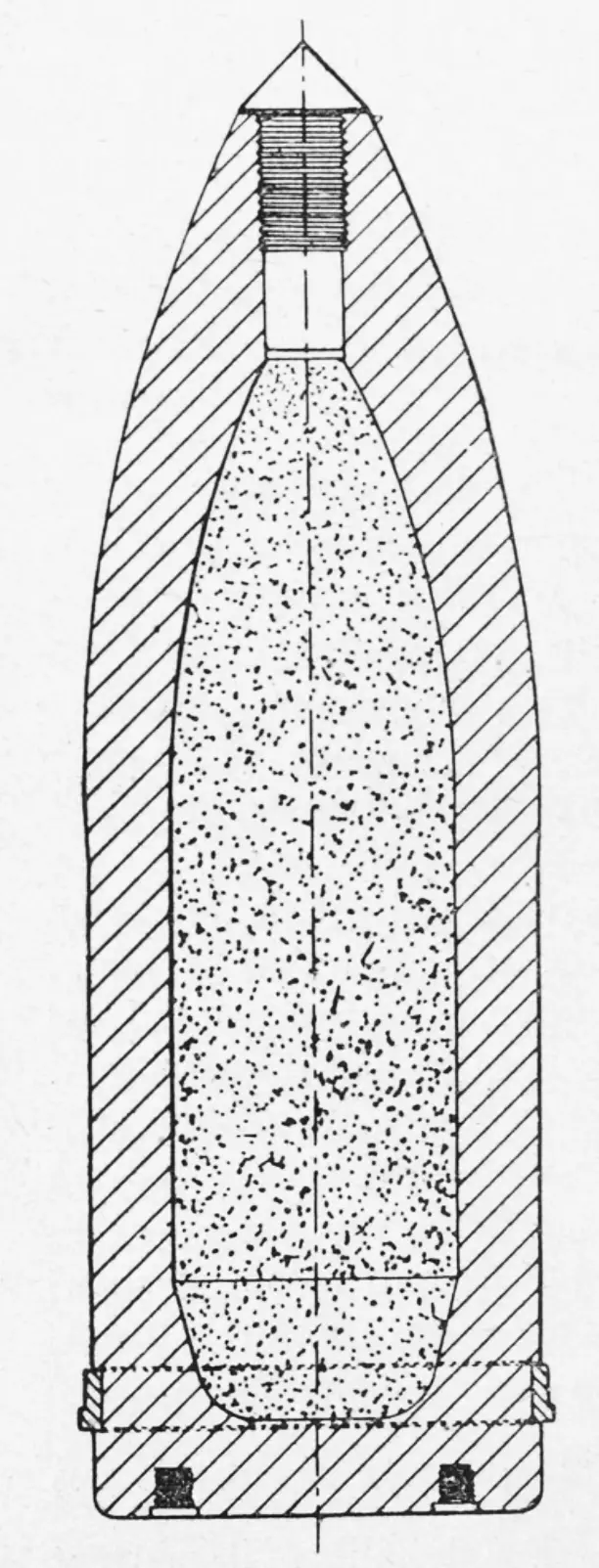
French 12-dm cast iron projectile
The Japanese Navy was armed with a forged steel general purpose projectile (鍛鋼榴彈) weighing 386 kg, filled with 39,2 kg of shimosa (pure picric acid). In the literature it is most often referred to as a high-explosive projectile.
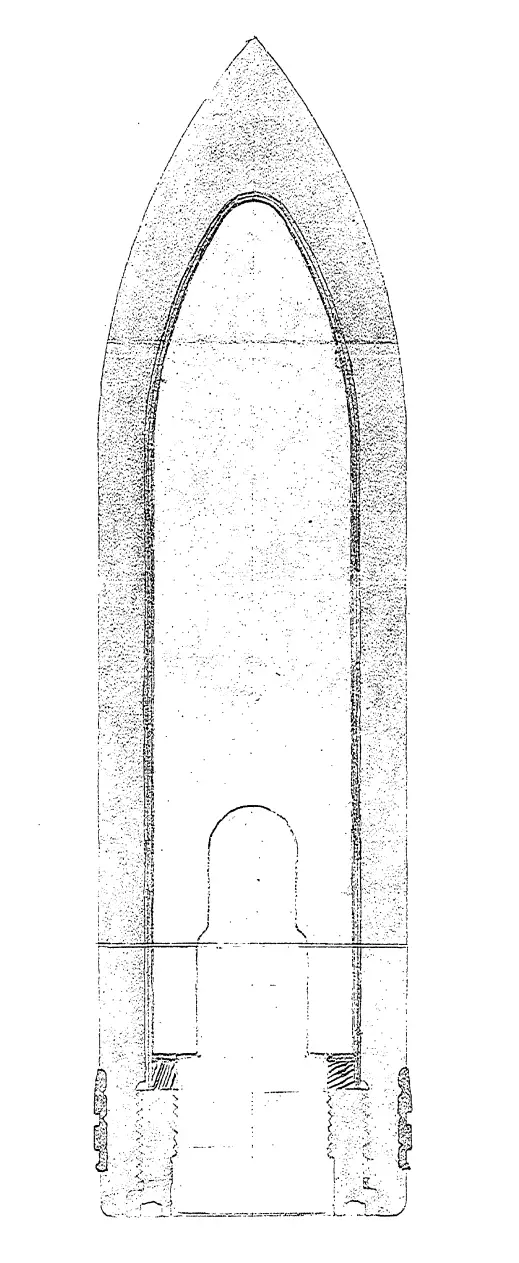
Japanese 12 inch forged steel general purpose projectile
In comparison with foreign analogues, the domestic high-explosive projectile was the shortest, had the thickest walls and the smallest charge of smokeless powder that was resistant to premature firing. This combination made it possible to penetrate 6...7-dm armor and explode behind it.
Similar shells from other countries had a larger explosive charge due to their smaller wall thickness. Black powder remained a popular explosive, producing large fragments and believed to have a strong incendiary effect.
The complete opposite of the Russian projectile was the Japanese one. It had very thin walls and a very large charge of highly explosive explosive. This combination often led to premature ruptures and incomplete detonation upon impact not only with armor, but also with light structures. In the unarmored side, the 12-inch “suitcase” tore a gap about two meters in size, creating a shower of relatively small fragments, but most of the explosion energy remained outside the ship.

Battleship "Eagle" after the Battle of Tsushima. Damage from a 12-inch Japanese high-explosive shell
Which approach to projectile design turned out to be correct: Russian or Japanese?
What is more important: the amount of explosive or the ability to penetrate deep into the ship?
The answers to these questions were given by the long and thorny path of the fleet of the mistress of the seas.
Bitter lessons of the Battle of Jutland
Impressed by the Tsushima triumph of high-explosive shells, the British relied on ammunition with the highest possible explosive charge.
The general-purpose projectile for the First World War received a massive hardened head with a soft cap (common pointed capped), but retained thin walls and a large charge of black powder. According to the plan, it was supposed to combine armor penetration and explosive effect, i.e. it was a semi-armor-piercing projectile.
In addition to the general purpose projectile, a thin-walled high explosive projectile was developed. It was forged from steel, had a head instant fuse and equipment from lyddite (picric acid). Due to the complete detonation of the explosive, the English high-explosive shell turned out to be significantly more powerful than the Japanese equivalent from the Tsushima era.
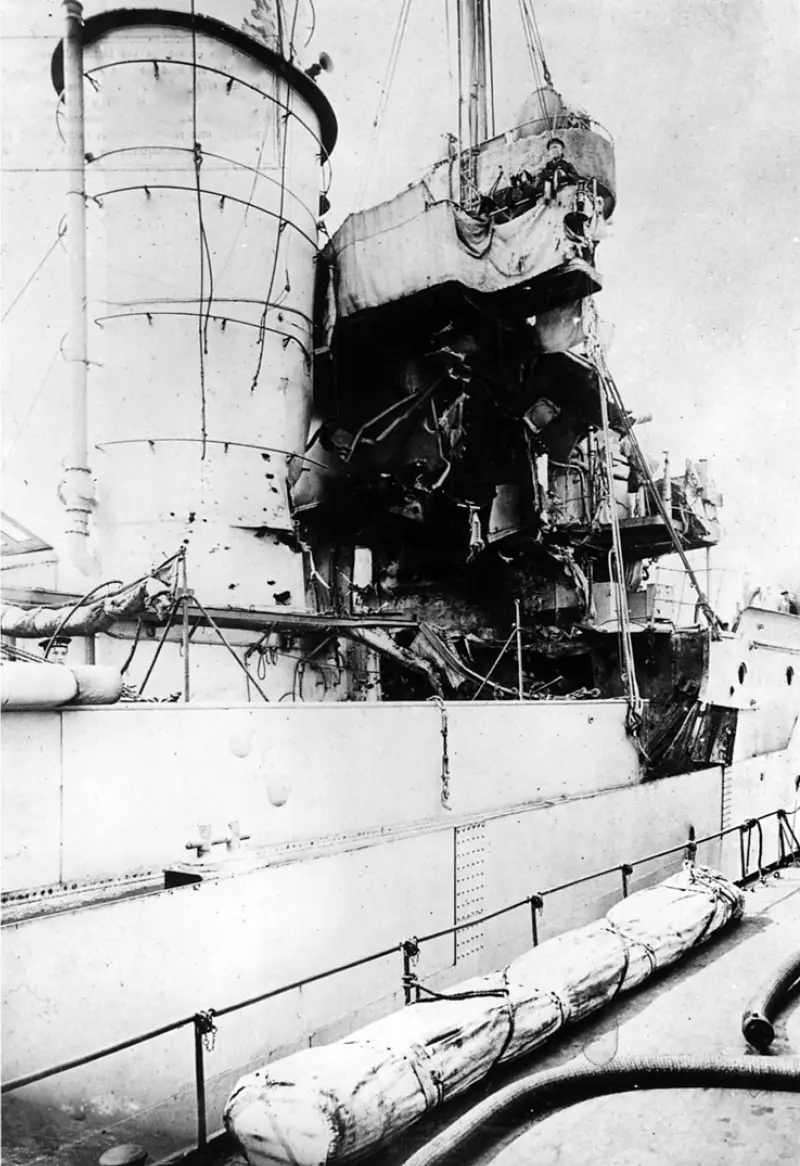
The cruiser "Pillau" after the Battle of Jutlan. Damage from a 12-inch English high-explosive shell
At the beginning of the First World War, the ammunition load of the 12-dm guns of English battleships and battlecruisers consisted of 35% general-purpose shells, 35% high-explosive shells and 30% armor-piercing shells.
The calculation was that at increased combat distances, land mines and general-purpose shells would destroy all unprotected and weakly protected parts of the enemy ship, ignite large fires, incapacitate the crew, disrupt control, and make it impossible to return fire. Armor-piercing shells were supposed to be used to finish off a damaged enemy.
In the Battle of Jutland, English shells turned out to be ineffective against well-armored ships. High-explosive shells could not cause damage when hitting even thin armor. The fragile walls of general-purpose projectiles were destroyed upon impact with armor at any significant angle from the normal. The bet on shells containing large amounts of explosive did not pay off. German shells, on the contrary, demonstrated their power by causing damage to the internal parts of the ship, even those protected by armor.
After the war, in 1919–1920. In England, large-scale shootings were carried out at the battleship Baden, the battleship Swiftshare and the cruiser Nuremberg. For large-caliber shells, the most effective, capable of destroying the internal parts of the ship, turned out to be an armor-piercing shell equipped with a delayed fuse.
The British came to the conclusion that 70% of the ammunition of large-caliber guns should be armor-piercing shells and only 30% should be general-purpose shells. There was no place for high-explosive shells in the cellars.
The descendants of the very shells that had a resounding success in the Battle of Tsushima were considered ineffective for large-caliber artillery.
Conclusions
The 12-inch high-explosive projectile of the 1894 model was high-explosive only in name. Thanks to its ability to confidently penetrate armor half its own caliber thick, such a projectile can safely be considered semi-armor-piercing. It successfully hit the inside of the ship with large fragments and a shock wave, burst upon impact with water and thin barriers, and did not have any critical flaws.
Claims made about the design of high-explosive shells after the Battle of Tsushima primarily concerned 10-dm and 6-dm high-explosive shells, which had a Brink fuse: insensitive, delayed and often did not fire.
Objectively, the only thing that can be blamed for the 12-inch Russian high-explosive projectile is that it was inferior to a similar Japanese projectile in the force of impact on the external parts of the ship.
But the combat experience of the First World War and the large-scale tests of shells carried out later proved that the impact on the internal parts of the ship was more effective.
Information